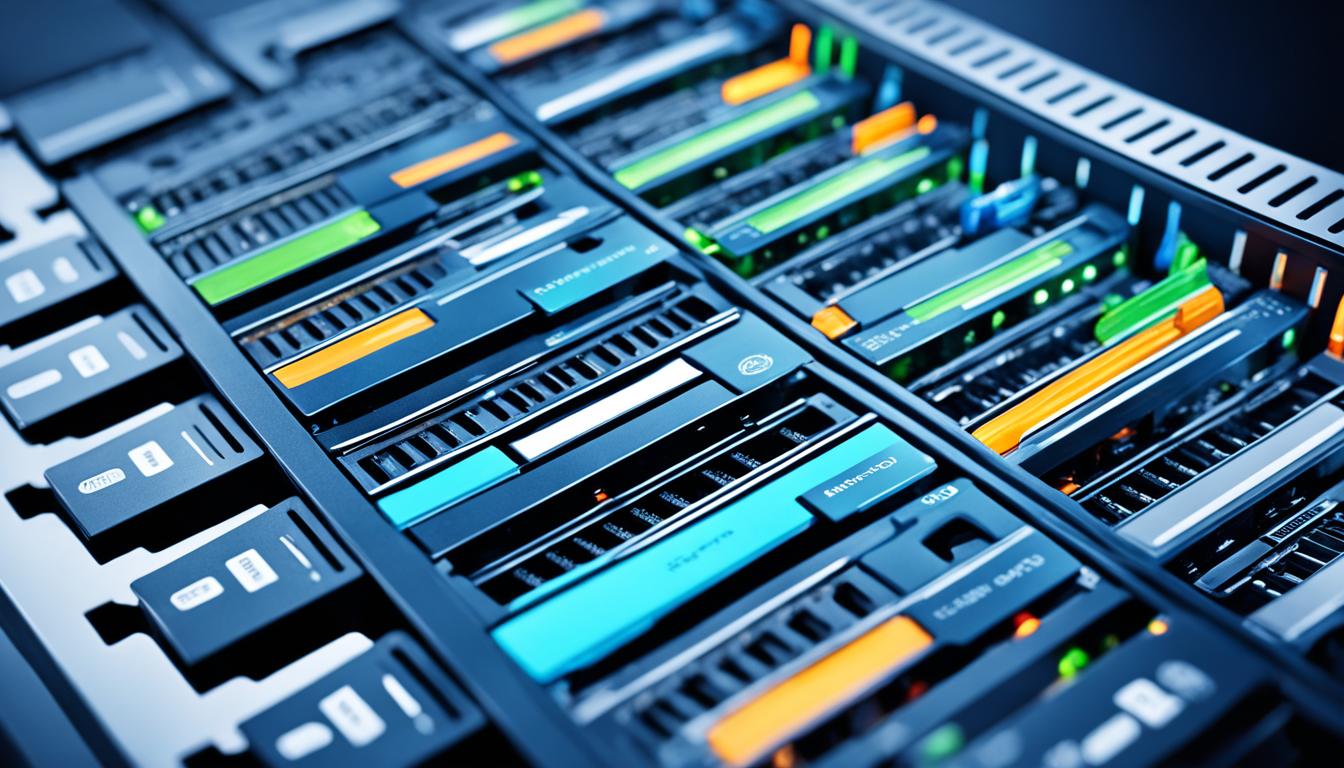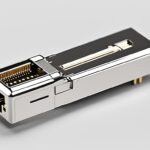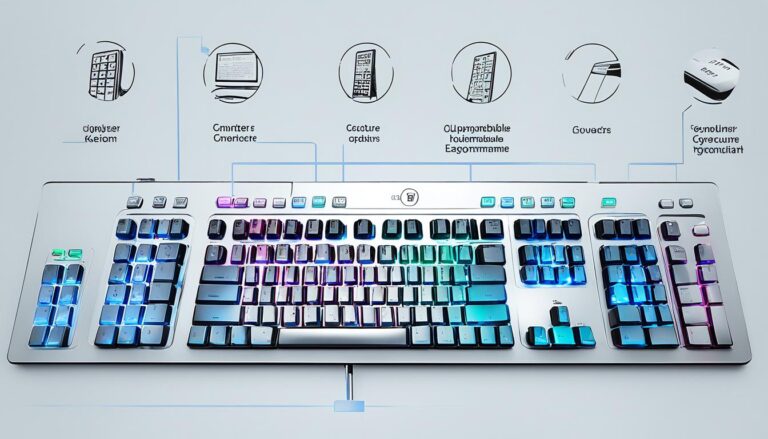A port server plays a key role in managing network connections. It ensures smooth communication and control within the network. The rise of cloud-based networks has made a strong port server even more important.
It offers the needed ports and protocols for services and applications. They need these to talk to client and other server systems. Knowing the right network ports and protocols helps keep the network running smoothly.
Understanding Network Ports and Protocols
Network ports and protocols make sure systems talk smoothly to each other in a network. They are like the rules for how data gets around. Knowing about them is vital for things to work well and data to move fast.
Windows Server has different versions and each uses specific port ranges. For instance, Windows Server 2012 and newer versions pick the high port range, between 49152 and 65535. But, older versions stick to a low port range, from 1025 to 5000.
Network services often depend on other services to chat across the network. Getting the ports and protocols right is key. This helps everything work as it should and keeps data moving without any breaks.
Default Dynamic Port Range for Different Versions of Windows Server:
| Windows Server Version | Dynamic Port Range |
|---|---|
| Windows Server 2012 and later | 49152 – 65535 |
| Earlier Windows Server versions | 1025 – 5000 |
It’s not just for Microsoft operating systems that setting the right ports and protocols matters. It’s key for all systems and apps. Proper set-up ensures safe and fast chats. It lets organisations tweak their network handling for smooth links.
“Understanding network ports and protocols is key to establishing smooth communication between systems within a network.” – Networking Expert
System Services and their Required Ports
In the Windows Server system, different services are key for network chats. Knowing which ports and protocols these services use is vital. This knowledge helps set up firewalls, routers, and other network gear for the best network performance.
Some key services in the Windows Server system include:
- Active Directory: This service manages network resources centrally. It needs certain ports and protocols to talk across the network.
- Lightweight Directory Access Protocol (LDAP) Server: The LDAP Server lets you access directory info. It uses specific ports and protocols for this.
- Remote Procedure Call (RPC): RPC lets networking processes on different systems talk. It also needs certain ports and protocols to work well.
These services in Windows Server need the right port settings to talk over the network. Each one uses specific ports. This makes sure the network traffic goes to the right service.
Setting up the right ports for these services is key. It helps client systems, server systems, and network devices talk to each other. Firewalls, routers, and other network gear need the correct setup. This lets the right network traffic in and out.
Port Configuration for System Services
Let’s look at Active Directory’s port needs:
| Service | Port Number | Protocol |
|---|---|---|
| Domain Controller (DC) | UDP 389, TCP 389, TCP 636 (LDAPS) | TCP/UDP |
| Global Catalog | TCP 3268, TCP 3269 (LDAPS) | TCP |
| LDAP | TCP 389, TCP 636 (LDAPS) | TCP |
The table shows which ports and protocols Active Directory needs. With the right firewall and network device setup, Active Directory can run smoothly. This supports the best operation of network services.
It’s vital for network bosses and IT experts to know about ports and protocols needed by system services. With the right setup, they can keep network chats flowing well. This keeps the network safe and running efficiently.
Configuration Manager and its Network Port Requirements
Configuration Manager is a powerful tool for managing and deploying software in big companies. It helps manage networks and needs certain network ports for communication. These ports are vital for its features to work properly.
To use Configuration Manager well, knowing the network port needs is key. This ensures smooth connectivity and that everything works as it should. Some ports you can choose based on your network, but others you must not change.
Firewalls and routers check if the necessary ports for Configuration Manager are open. By setting these up correctly, you can keep your network running smoothly. This is crucial for managing your system well.
Let’s look more at which network ports Configuration Manager needs:
Client Communication Ports
Clients talk to servers using specific ports for different tasks. Here are some important ones:
- Port 445 (TCP): For file and printer sharing.
- Port 80 (TCP): For HTTP traffic during client setup and updates.
- Port 443 (TCP): For secure client talks using HTTPS.
- Port 8530 (TCP): For talking to the software update point.
Server Communication Ports
The server also needs certain ports to talk to clients and other servers. Some vital ones include:
- Port 1433 (TCP): For talking to the SQL Server database.
- Port 4022 (TCP): For SQL Server Service Broker talks.
- Port 2701 (TCP): For out-of-band talks with managed devices.
- Port 8531 (TCP): For talking to the software update point using HTTPS.
These are just some ports that Configuration Manager uses. Make sure to check Microsoft’s documentation to get them right. It’s crucial for ensuring your system talks smoothly.
Configuration Manager’s documentation has all you need on network ports. By following it and working with your network team, you can set up the right ports. This ensures seamless communication across your network.
| Port | Protocol | Description |
|---|---|---|
| 445 | TCP | File and printer sharing |
| 80 | TCP | HTTP traffic for client installation and software updates |
| 443 | TCP | Secure client communication using HTTPS |
| 8530 | TCP | Communication with the software update point |
| 1433 | TCP | Communication with the SQL Server database |
| 4022 | TCP | SQL Server Service Broker communication |
| 2701 | TCP | Out-of-band communication with managed devices |
| 8531 | TCP | Communication with the software update point using HTTPS |
Network Ports for Clients and Site Systems in Configuration Manager
In Configuration Manager, clients and site systems need certain network ports for smooth communication. These ports support different types of interactions, like:
- Client-to-site communication: This is where client systems talk to the main site server. It lets clients get instructions, policies, and settings from the server. This is key for good management and teamwork.
- Client-to-cloud communication: This allows clients to connect with cloud services. It’s vital for getting software updates, using cloud apps, and syncing data with the cloud.
- Distribution points: These are spots in Configuration Manager that hold software, operating systems, and content for deployment. They need certain ports to send out content to clients quickly. This makes sure deployments and updates are on time.
- Management points: These points help manage client activities. They let admins keep an eye on and control client setups, compliance, and software installations. Ports for management points make sure the server and clients can talk without issues. This helps in effective management and fixing problems.
- Software update points: These are crucial for managing software patches in Configuration Manager. They use specific ports to download and share updates with clients. This keeps systems secure and up to date.
Communication can go one way or both ways, depending on the situation. To make sure communication works well, firewalls and network devices must let the needed ports through. By doing this, organisations can manage resources well, keep deployments safe, and maintain smooth communication in their Configuration Manager setup.
Below is a picture showing the network ports clients and site systems use in Configuration Manager:
Conclusion
A port server is key for top-notch network management and smooth connections. Knowing the right network ports and protocols is crucial. Organizations use this info to set up firewalls, routers, and more. This keeps communication clear between different systems. For Configuration Manager, it’s important to know which network ports are needed. This ensures everything runs smoothly.
Using a tough port server and setting up the needed ports makes managing networks better. This helps businesses use their resources well. They can send out software updates and keep connectivity constant. With the right port server setup, businesses can look after their network connections. This keeps their network stable and safe.
It’s essential to manage network connections for efficient operations. A port server lets businesses keep an eye on network connections well. This ensures easy talking between systems. Also, knowing about network ports and protocols helps set up security measures better. This includes firewalls and routers. With good network management, businesses can improve their operations. They enjoy dependable and strong network connectivity.
FAQ
What is a port server and why is it essential for managing network connections?
A port server is a key device for controlling network connections. It supports smooth connectivity and command over networks, ideal for cloud-based settings. This device offers the right ports and protocols. These are needed for services and applications to communicate.
Why is it important to understand network ports and protocols in Microsoft operating systems?
Understanding network ports and protocols is critical, particularly in Microsoft systems. Different programs and services rely on particular ports and protocols to connect. Knowing the default dynamic port range for Windows Server versions helps keep the network running smoothly.
Which system services require specific ports and protocols for network communication?
In the Windows Server system, certain services need particular ports and protocols to talk. Services such as Active Directory, LDAP Server, and RPC are examples. Knowing what these services need helps set up firewalls and routers properly.
What are the network port requirements for Configuration Manager?
Configuration Manager is vital for managing software and updates in businesses. It needs certain ports for communication. Some ports are flexible, others must stay open. Firewalls and routers should be adjusted to open required ports for it to work correctly.
What network ports are required for clients and site systems in Configuration Manager?
Configuration Manager’s clients and site systems need specific ports for talking. These are needed for different kinds of communication, like between clients and sites, or with the cloud. It’s vital to set up firewalls and other devices to allow these ports. This ensures smooth management and deployments.
How can a robust port server and proper port configuration enhance network management efficiency?
A good port server is crucial for efficient network management. When you know which ports and protocols are needed and set up devices right, you boost your network’s efficiency. This leads to better connectivity without interruptions.












